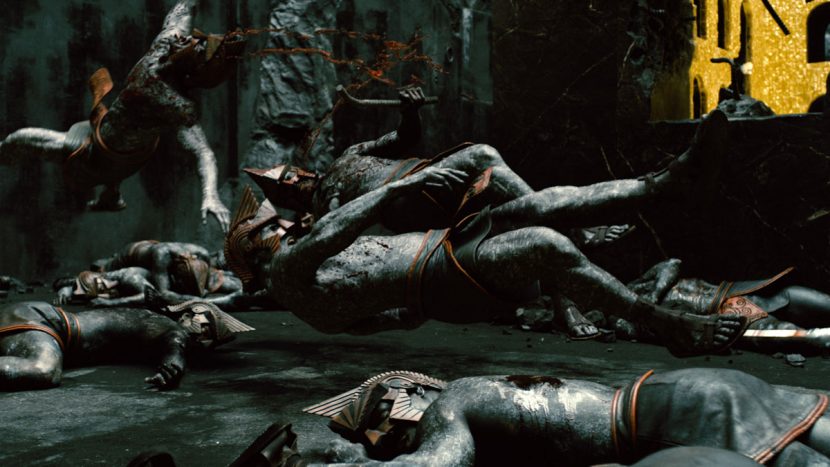A stand-out sequence in Tarsem Singh’s Immortals takes place near the climax of the film, when King Hyperion frees a group of entombed Titans from their cell using the powerful and magical Epirus Bow. But before the released Titans can escape, the Gods descend from Mount Olympus and work to dispatch them. A bloody close-quarters fight ensues, with Tippett Studio combining live action footage, motion captured performances and CG Titans and effects to create the final shots.
In particular, the battle is punctuated by something known as ‘God Speed’ to emphasize the otherworldly powers of the Gods and Titans. “When the Titans died,” explains Tippett Studio visual effects supervisor Matt Jacobs, “they wanted them to take on a slow motion effect. So when you see them get chopped in two or a head chopped off or smashed by Zeus’ chain they wanted it to feel more photosonic – around 500 frames per second – so there was a speed ramp as the Titan dies and then goes into slow motion.”
We talk to key members of the Tippett team about how they realized the animation, effects, lighting and compositing for the Gods versus Titans fight.
Above: Watch a breakdown of Tippett’s visual effects for the Gods vs. Titans battle. Warning: not suitable for persons under 18.
Filming
An initial detailed previs effort was carried out by overall visual effects supervisor Raymond Gieringer and the effects design team, which specified the action of five individual fights between the Gods – Zeus, Poseidon, Athena, Heracles and Apollo – and the Titans. On set, stunt Titan actors in black and crackley textured make-up fought against the Gods actors in a battle orchestrated by fight choreographer Jean Frenette. Clean passes with just the Gods acting out their moves were also filmed. DoP Brendan Galvin captured plates on the Panavision Genesis in mono (the final shots were post converted to stereo) at either 24 or 48 fps.
Later, a motion capture shoot took place with the same stunt actors, in anticipation of all of the Titans being created as CG characters by Tippett. But the scope of the fight and the impressive stunt performances led to a change in the approach. “The choice was made to actually use production footage of the Titans and then, when they were killed, we would insert our CGI Titans,” says Matt Jacobs, who oversaw Tippett’s work along with visual effects producers Ken Kokka and Sabina Fredenburg.
During the mo-cap shoot, the stunt performers attempted to replicate the live-action portions of the fight filmed earlier. “We had studied the fight extensively from what had been laid out by the stunt co-ordinator Jean Frenette,” notes Jacobs. “We knew all the parts of the fight but over the course of three or four days had to mo-cap every part of it we needed. We broke it down into individual elements and larger sections, and really dissected the choreography to get all the data we needed.”
Animation
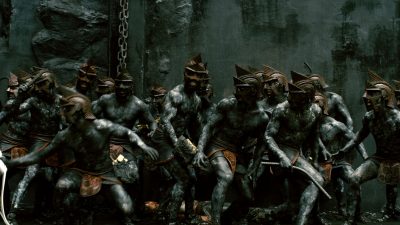
The mo-cap data was then processed – Michael Brunet had served as on-set animation supervisor – and the cut turned over to Tippett. “Generally, our animation guys would start with the motion capture,” says Jacobs, “then massage it into place and take over whenever a Titan was killed because we were chopping off heads and splitting guys in two down the middle of their bodies in a cross-section. I’d say it’s 80% animation and 20% mo-cap, but the motion capture was a great basis for the shots – it would have taken a lot longer if it had been fully hand-animated.”
Immortals was Tippett’s first foray into motion capture work, and so required augmentation to the existing Maya pipeline to incorporate MotionBuilder. “Our puppet/rigging department led by Eric Jeffery did a great job of figuring out how our Titans rig could be plotted onto the mo-cap motion,” says animation supervisor James Brown. “Then once we had it on our rigs we brought in Rick Thomas who did the MotionBuilder to Maya transfers. He had a lot of experience in tackling the data and just letting the animators focus on the animation, which was a nice blend of mo-cap and keyframe.”
For Brown, the most challenging aspect of combining mo-cap and keyframe was “when we didn’t have a motion capture pass for a particular shot – well, then you’ve got to hand-key that stuff.” The solution, however, was to look to the original live action fight choreography as reference, as well as video of the mo-cap shoot which had also been taken. “Overall, the fun part of this show was that we just had to fight,” adds Brown. “As a VFX junkie, animating deaths was actually a lot of fun. And if it looked cool, it was cool – that was our bar of measurement – make them look tough, brutal and as gruesome as we could.”
To deal with the photosonic aspects of the fight – the story point being that the Titans and Gods move so fast that humans cannot see them until they die – animators actually manipulated different parts of the bodies at different times. “Our initial approach was to slow it down,” recalls Brown, “but then it would look a little boring. So we would move an arm faster than the head, then make the torso drive the action, trying to make it feel like something was pulling the Titan from behind as he gets cut in half.”
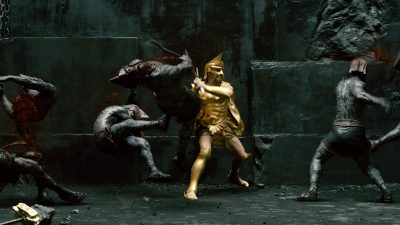 In fact, the slow motion look had to work not only in each shot but also across the cut to suit the dramatic blood effects. “We couldn’t have anything pop or come to a complete stop because that would throw a whole monkey wrench into the CG department doing the blood,” says Brown. “So we developed something called Master Shots. As an animator you’d work in a bunch of shots in one Maya scene and that allowed us to ensure the motion was consistent across the cut.”
In fact, the slow motion look had to work not only in each shot but also across the cut to suit the dramatic blood effects. “We couldn’t have anything pop or come to a complete stop because that would throw a whole monkey wrench into the CG department doing the blood,” says Brown. “So we developed something called Master Shots. As an animator you’d work in a bunch of shots in one Maya scene and that allowed us to ensure the motion was consistent across the cut.”
A muscle pass for the Titans was also added to deal with weight and jiggle, while small animation details became crucial in selling the fast-paced scene. “We had this simple expression for the face,” comments Brown. “It’s amazing how much you can see by just doing a small mouth movement – you could really sell the character as real. We also added some foot squish when their feet hit the ground and the toes slightly spread out which really helped sell the weight coming down on the foot.”
The more gory parts of the fight – when the Titans are decapitated, lose their limbs or are even sliced in half – required separate rigs for different body parts. “We had to develop these two rigs on top of each other,” says Brown, “and then rig-swap over one frame, where there’s a pre-frame before the Titan gets sliced. You’d do the entire animation through and then find your slice point, and then at that point you switch rigs and start animating body parts flying off. You have to try to get them to sync up – they had to match up for a good 10 to 20 frames ahead of the slice in order for it not to cause problems in effects. Then there was a lot of back and forth with effects to get the blood spray to work with the pieces.”
Effects
Another signature aspect of the Gods and Titans confrontation is the stylized blood emanating from the victims. For that, Tippett embraced Houdini for the fluid dynamics work. “When we came onto the film,” says Matt Jacobs, “the scene was described as a ‘ballet of blood’. We knew that the blood had to be almost like a character in the shot. We used Houdini and also our own in-house surfacer for the blood and did all of the meshing with proprietary software.”
Lead FX artist Scott Singer experimented first with the right look and feel of the blood spurts. “Houdini had announced their FLIP fluids just before we had to do some test images,” he says. “I’d been working in Maya using their particle fluids and was applying a lot of interesting engineering and we were getting some pretty good results, but I decided to try Houdini. In my own time I would play with it and I found that by using the FLIP solver and emitting particles it was looking as good as what we had already come up with.”
The blood itself fell into three categories. Firstly, there was a sheet of blood seen as broad ribbons, then a ‘schwap’ element, described by Singer as “the undefined splattery bits that would come of the huge horrific wounds, which were done in both Houdini and Maya.” Finally, a misty fog layer of almost atomized blood was added using Maya, although this became dialled back later on when the director preferred the strong graphic quality of the sheeting blood.
The scene data for the blood effects was cached in the GTO file format (although Tippett plans to move to Alembic when it can). “The environments and the characters and the weapons and all of that came to us from Maya,” explains Singer, “and exported into these GTO files. From that point we could take them back into Maya or Houdini to do the fluid effects. Then we exported it all back out and it rendered the same way.”
The blood matches, of course, the photosonic shots, but to create the slow motion look, artists had to ‘lie’ to the solvers in Houdini. “Basically we had to tell it that time was going at a really bizarre rate,” says Singer. “We had to either speed up or slow time down. We also had to lie about how big things were in the screen. We would tell it, ‘Hey, here’s a six foot tall Titan,’ but he was really only a foot and a half tall. So the blood coming out of it is now only an inch and a half wide instead of a two foot wide ribbon. When you start to lie about physics it will hold together well for a few frames but then starts to fall off pretty quickly as the shots get longer.”
“We also wrote some special drag forces that we could apply,” continues Singer. “When the characters would get hit with a weapon, they would go into this two or three frame over-acceleration before they would go into slow motion. That contrast would accentuate the punch of the moment. We had to make all the dynamics match that. They would be differential based on the velocity, so we could get huge explosions. We’d over-damp them and then ease off on the damping. That was really helpful for getting that initial sense of exploding at a million miles an hour and suddenly being arrested over the course of a few frames – great for the schwap elements.”
In addition, effects work was required for the Titans’ skirts. “The anim team did a little bit of animation on the skirts making sure they moved very suddenly across the transition,” says Singer. “We could sim them up to the transition and clamp all the sim off across the transition and ease it back in as they went into slow-motion. Animation were very good in making sure the legs didn’t stick through the skirts and that sort of thing. There’s also a flap at the front of the Titan’s skirt – we had a fair amount of difficulty sim’ing that, just because in the ultra slow-mo the simulation engine wasn’t getting enough input for it to stay alive. It would just lock off, so the animators applied a hand-animated twist to that element.”
The shot in the effects department that turned most heads was called the ‘fly paper’ shot. Here, a Titan is thrown against a wall, but then comes off of it very suddenly before slowing down into photosonic mode. “The effects were done by Jonathan Ramos for that shot,” notes Singer. “We were asking for artwork from production because it was a particularly graphic moment and they did a great paint-over where they wanted the blood to happen and where they wanted it to stream and fall apart. And then using dynamics and special shape emitters, Jonathan was able to hit the artwork almost perfectly.”
Lighting
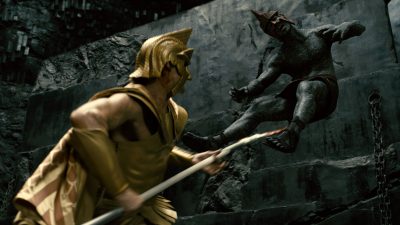 In another first for Tippett, the studio implemented ray-traced area lights for the fight sequence to achieve a more physically accurate lighting response off the characters. In the past they had relied on simpler CG spotlights. That new set-up was spearheaded by CG supervisor Aharon Bourland. “In the scene the Titans were basically just humans with a very elaborate displacement texture on them,” says Bourland. “The lighting had to be very real and the shadows very accurate in the plate so that they felt really real, because you could get into the Uncanny Valley very quickly with them.”
In another first for Tippett, the studio implemented ray-traced area lights for the fight sequence to achieve a more physically accurate lighting response off the characters. In the past they had relied on simpler CG spotlights. That new set-up was spearheaded by CG supervisor Aharon Bourland. “In the scene the Titans were basically just humans with a very elaborate displacement texture on them,” says Bourland. “The lighting had to be very real and the shadows very accurate in the plate so that they felt really real, because you could get into the Uncanny Valley very quickly with them.”
Past shows for Tippett had generally involved significant fur work, something that historically had been expensive to use area lights for. “But when Immortals came along,” recalls Bourland, “and it was all hard parts – in terms of the raw geo – so we thought this was a good chance to test a different method. We knew it would take a lot longer to render compared to spotlights, but actually compared to a fully furred character the render times weren’t that bad.” (The system has since been successfully used for Tippett’s wolves on The Twilight Saga: Breaking Dawn: Part 1).
With software engineer Mike Farnsworth, Bourland re-wrote Tippett’s RenderMan shaders to enable the new area light set-ups. “We built it from the ground up allowing multiple sampling which made it really easy to go to area lights from spotlights. The one big advantage of having more physically based lighting was that we could have just one or two lighting set-ups for the entirety of the shots. We could re-create the lighting they used on set. Since it was all shot on one location, we didn’t have to do nearly as much shot-specific lighting which was a benefit that I don’t think we had thought of when we started.”
“Our approach also worked well because as the lights got bigger the spec would broaden out,” adds Bourland, “and the shadowing would get better and the diffuse would wrap nicely. You wouldn’t get hard, weird shadows. It gave you much more form off the characters.”
The lighting team (Howard Campbell was the lead lighting technical director) implemented what Bourland refers to as ‘creative sloppiness’ into the scenes. “I really like naturalistic lighting – not making it so art directed. I feel like a lot of CG gets over-lit and over-directed. Artists sometimes try and get every rim and every light perfect on the character, but I actually like it when it’s a little sloppier. When you’re shooting things for real you light the best you can but it’s not like you hit every single light perfectly as the actors are walking around. Creative sloppiness involved just putting the light somewhere and letting the character walk through it – not tracking the light to them.”
The CG work extended also to techniques for revealing the slashed internal parts of the Titans in an efficient way – not having to model every single organ. Says Bourland: “When the guys are ripped apart we had to come up with a fast method to show them being dismembered in crazy ways. We would do an initial pass on modelling, and then we would sculpt the end cast as flat planes, but then we took them into Mudbox and would do elaborate sculpts on them and use vector displacement to do all the internal organs. We could turn on and off the surface parameters and have the blood and guts and lungs falling out. It sounds a bit gruesome but it’s so incredibly choreographed that it’s pretty.”
Compositing
Although the fight combined live action, motion capture, CG Titans and effects, the compositing, according to compositing supervisor David Schnee, remained within reason. “We had your typical re-times, plate clean-up and times when we had to make some of the action a little snappier to emphasize certain moves and strikes,” he says.
Tiles were shot all around the set to enable room to move the camera and re-compose certain scenes if needed. Tippett’s Christopher Paizis was the matchmove lead. The scenes were all comp’d in 2D in Nuke, and elements later broken out to allow for the stereo conversion. An initial effort to give the Titans and Gods a vibrating look in order to sell their speed was undertaken, but the approach changed to the photosonic feel. Additional comp fixes included adding some more transparency and sub-surface feel to the blood where needed and matching some of the live action Titans with their CG counterparts, occasionally fine-tuning markings on helmets or skirt and sandal trims.
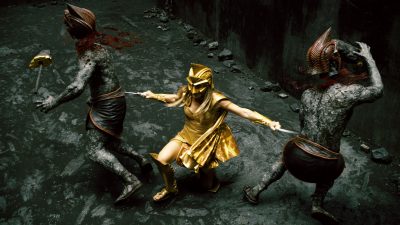 “Our biggest challenge though,” says Schnee, “was dealing the projections that we needed to help pad all the wounds that would occur when the Titans were severed and heads lobbed off. They built some nice wound artwork on all the caps for that stuff but there wasn’t enough time to go in and do a lot of interesting dressing of paintwork that would have blood splattered onto skin and dripping down the contours of their body and on clothing. So we came up with a pretty cool projection set-up gizmo in Nuke to handle that.”
“Our biggest challenge though,” says Schnee, “was dealing the projections that we needed to help pad all the wounds that would occur when the Titans were severed and heads lobbed off. They built some nice wound artwork on all the caps for that stuff but there wasn’t enough time to go in and do a lot of interesting dressing of paintwork that would have blood splattered onto skin and dripping down the contours of their body and on clothing. So we came up with a pretty cool projection set-up gizmo in Nuke to handle that.”
The projection technique began with a key pose of a Titan, fully dressed and mocked up, with a camera target and locator to project onto. “We could then easily place our splatter or drips onto him,” says Schnee. “That would get un-UV’d and applied to the animated GTOs for the shot.”
In one hero shot, a chain goes through the chest and impales a Titan. “For that there was a little bit of dressing on the Titan for the wound,” notes Schnee. “But then he also ends up dropping and stepping towards the chain towards camera. The CG blood that is blasted off from the impact bursts out in front of him and then he steps into it. So the artist on the shot animated certain timings of the projection to time with the CG blood, which we had as a number of effects passes.”
The final shot
Tippett’s overall shot count on Immortals came to 96, made up also of a CG hyena-like ‘mongrel’ that replaced a live action German Shepherd for a couple of shots, and CG Titans added to the film’s final complicated ‘Sistine Chapel’ pull-out, which was shared with RedFX in Montreal.
“That shot had been done originally for a teaser trailer,” says Matt Jacobs. “It was filmed in photosonic stereo for everything in the foreground and then in the background the characters were on a multi-planes and multi-directions – all these Gods and Titans fighting at the same time. It was literally hundreds of takes on greenscreen that went into the shot. Tarsem wanted to gore it up so we added CG Titans, blood simulations and parts flying in slow motion, taking some cues from the death effects we had done already. We also inherited a massive Nuke script from RedFX and there was a lot of co-ordination with them to get all the assets. Then we integrated our work into it, and passed it back to them to do some finishing.”
All images and clips copyright © 2011 Relativity Media.

